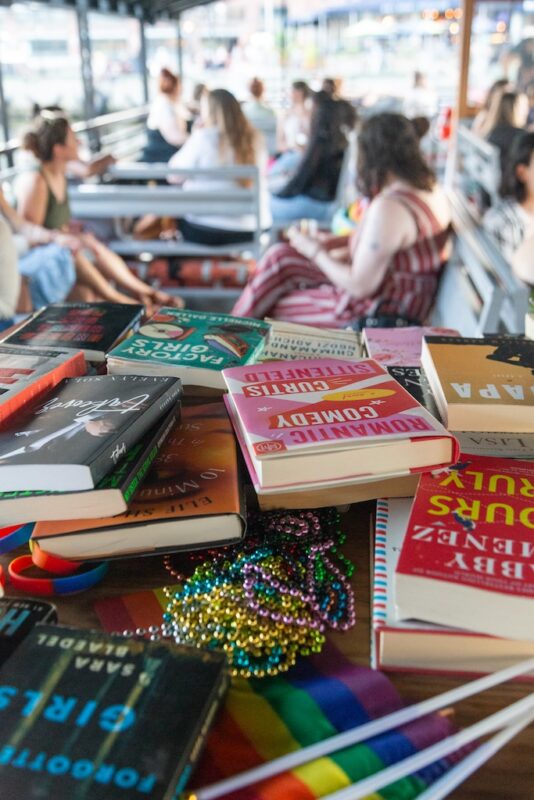There was a lot of news again on the internet this week. Highlights: No White Saviors, who is the “acceptable” face of abortion, Webb telescope images, narwhals teach pleasure, Lea Michele and Beanie Feldstein, horny brands, Cora Harrington on Victoria’s Secret, Sri Lanka, Foley, and family photos.
1. Input: The spectacular implosion of Instagram’s No White Saviors
A few years ago, a friend of mine asked me if I’d ever heard of the Instagram account No White Saviors. I hadn’t—I don’t spend much time on social justice Instagram—and my friend, who is a white woman, explained the premise of the account: a white woman canceling white people for being white saviors. My friend’s description was mostly right, but not totally accurate. The account was co-founded by Kelsey Nielsen, a white woman, and Olivia Alaso, a Black Ugandan. However, my friend’s intuition about the account—that it was nefarious and had an extreme savior complex—seems right.
The duo “request[ed] donations to their Venmo, PayPal, and Patreon accounts — telling them it was being earmarked to fund charity work and to defend itself from lawsuits from the people it had canceled online.” Dionna Owens, whose ex-husband used to work with the account and had an affair with Nielsen, said that “[Nielsen] would target these people just so she could cancel them, because that’s where the money comes from,” and had “never seen the benefits of No White Saviors money going to anything.” It turns out that many of the accusations and “money-making cancellations were often based on falsehoods.”
2. The Cut: A 10-Year-Old Survivor Shouldn’t Be the Face of This Fight
This week, the story of a 10-year-old rape survivor who had to travel out of her home state of Ohio to get an abortion—at six weeks and three days pregnant, she was over her state’s legal limit—became fodder for online discourse. Multiple news outlets reported the story as a hoax after “President Biden cited the child while announcing his executive order on abortion access.” As a 10-year-old child has been thrust into the contentious public debate of abortion, it begs the question, “what are we putting survivors through when we ask them to be the ‘acceptable’ face of abortion, when we politicize their most painful traumas to advocate for basic health-care access?”
3. NASA: NASA Reveals Webb Telescope’s First Images of Unseen Universe
NASA released the first images from the James Webb Space Telescope this week. “These images, including the deepest infrared view of our universe that has ever been taken, show us how Webb will help to uncover the answers to questions we don’t even yet know to ask; questions that will help us better understand our universe and humanity’s place within it,” according to NASA ambassador Bill Nelson.
4. Sierra: Satellites Stalk Narwhals From Space, But They Still Keep Secrets
I’m always so impressed by Alexis Pauline Gumbs’ rigorous dedication to dreaming. In this short essay, which reads like a poem, Gumbs uses narwhals as a metaphor to discuss pleasure, writing that “we are the ones who grow up distrusting where our pleasure is leading us,” urging us to reimagine the role of pleasure in our lives.
5. Slate: Why the Internet Is So Obsessed With Lea Michele Replacing Beanie Feldstein in Funny Girl
I am part of the internet that is obsessed with Lea Michele replacing Beanie Feldstein in Funny Girl. In September, Michele will replace Feldstein, who played the main character Fanny Brice this year in the first revival of the storied musical since its original run, which began in 1964. The musical was Barbra Streisand’s breakout role, and one Michele has publicly coveted over the years, with many referring to her tenure on the TV show Glee as her “six-year audition for Funny Girl.”
It is generally assumed, although not confirmed, that Michele was in the running for the initial casting, but “speculation for where she went wrong has centered on her reputation for diva behavior and worse. In 2020, after Michele posted on social media in support of the Black Lives Matter movement, a Black co-star of hers from her Glee days, Samantha Ware, called out how Michele had treated her on set, and several other actors backed up Ware’s accusations with further charges of bullying and cruelty.”
Why I’m obsessed with the drama is because the internet has jokes. Apart from an unsubstantiated rumor surfacing that Michele can’t read, people are comically wondering if we are living in a Glee storyline. Michele’s character on Glee, Rachel Berry, “performed the Broadway show’s signature song, ‘Don’t Rain on My Parade,’ in Glee’s first season, and the character went on to perform many other songs from it over the show’s run. There was always a fair amount of blurring between Berry the character and Michele herself, so when viewers saw a striver type who made it clear she would do anything to be a Broadway star, and who especially modeled herself on Streisand, they associated those qualities with Michele as well.” There is even a storyline in the show where Berry is cast as Fanny Brice in Funny Girl. There is an inescapable sense of art imitating life here. And yes, as @hennyondattweet most accurately describes the drama, “she’s annoying and deeply problematic but Lea Michele was cooked up and grown in a lab to play this role and not a thing was gonna keep her from it.”
6. Vulture: When Brands Got Horny
Corporate brands on Twitter are wild, but it hasn’t always been this way. In the beginning, brands started creating personalities on Twitter, which then evolved: “Brands from Burger King to Gushers announced anti-racist and antiwar stances; dipped their toes in feminist, pro-LGBTQ-rights, and pro-mental-health-awareness conversations; became fans of anime and weed; and got angsty,” writes Nathan Allebach. As “the general population has been unapologetically horny on main since 2018, thanks in part to the gradual destigmatization of sex work and porn,” brands are hornier than ever. Somewhat subtle at first, “as more risks tend to yield more rewards online, things escalated. They started acting blatantly aroused to bait engagement with explicit references to sex, orgasms, and more NSFW content that apparently is now suitable for work — at least for companies themselves.”
7. Twitter: Cora Harrington on Victoria’s Secret: Angels and Demons
Matt Tyrnauer’s new three-part documentary about Victoria’s Secret aired on Thursday and “[tracks] the rise and fall of one of the best known lingerie companies on the planet.” Writer and lingerie expert Cora Harrington live-tweeted her response to the series, which largely focused on Jeffrey Epstein’s connection to the company. Harrington doesn’t “necessarily disagree with that…but I think the formatting of the documentary needed to be better and/or that the focus on Epstein needed to be stated more clearly. This is mostly an Epstein documentary, not a VS one.” In addition to her thoughts on the series, Harrington also provides a lot of historical context on VS.
8. Democracy Now!: How Sri Lanka Protests Led to a “Reawakening of the Citizen” & Pushed Out President & Prime Minister
Sri Lanka’s President, Gotabaya Rajapaksa, resigned on Thursday, after months of civilian protests and demonstrations, including storming Rajapaksa’s home. The president “face[d] accusations of corruption that bankrupted the country and led to a massive economic crisis.” The economic crisis has “become a political crisis, as well, so it’s a combined situation in Sri Lanka. And now it’s also there is a situation where we are seeing an unfolding humanitarian crisis, so multiple challenges on the ground,” as human rights lawyer Bhavani Fonseka explains in this segment.
This segment aired on July 12th, before the resignation, but offers a good overview of how the crisis evolved.
9. The New Yorker: The Weird, Analog Delights of Foley Sound Effects
Over the past week I’ve started obsessively watching Star Wars films. I started with Episode I and watched in numerical order through Episode IX, and now I’m re-watching in the order the films were released. I’m in no way part of the Star Wars fandom, and had only seen most of the series once or twice, and I usually don’t give much thought to the films while watching them. But, as I watched at least 24 hours of the series, I kept thinking about the sound of lightsabers.
In film, foley artists recreate the sounds of everyday objects or actions: “They might include the sound of someone walking across a room, rolling over in bed, stirring a pot, typing, fighting, dancing, eating, falling, or kissing,” writes Anna Wiener. “The line between the two kinds of effect is thin: Foley artists record the sound of a hand twisting a doorknob, but not the sound of the mechanism turning within. Foley is subtle but suggestive, capturing offstage bedsprings, or the shuffle of a clumsy intruder. In the past hundred years, technology has changed the process of recording, editing, and engineering sounds, but the techniques of Foley have remained stubbornly analog.” Foley artists are few and far between, yet the “bulk of the sound in film is typically added in postproduction,” and “Foley effects are custom to a film, and are synchronized to characters’ movements.”
There were lots of examples from Star Wars in here, although none about lightsabers specifically. But according to Wikipedia, “The lightsaber sound effect was developed by sound designer Ben Burtt as a combination of the hum of idling interlock motors in aged movie projectors and interference caused by a television set on a shieldless microphone.”
10. The New Yorker: The Secret Art of the Family Photo
Much to my dismay, on my most recent trip to my childhood home I noticed my parents proudly displayed some of my middle school photos above the fireplace. My childhood house doesn’t have many family photos around, and if they are on display they are not in shared places. We don’t take professional photos, and I don’t even know if we’ve taken a family picture every year.
Despite not growing up seeing family photos in my everyday life, I’ve been thinking about them a lot recently. My grandmother passed away a few years ago, and since then my mother has been slowly going through her house and belongings. She keeps finding pictures from her childhood—photographs she hasn’t seen in decades and I’ve never seen at all.
Michael Johnston has been taking photographs for four decades and reflects on what he has learned. As I keep learning about bits of my mother’s history, I think about Johnston’s “[belief] that the more that’s known about what a photograph shows, the more likely it is to survive. Don’t be shy about trying to record what you know about a picture, and about finding some way of keeping the picture together with its story.”






